di Marta Lock
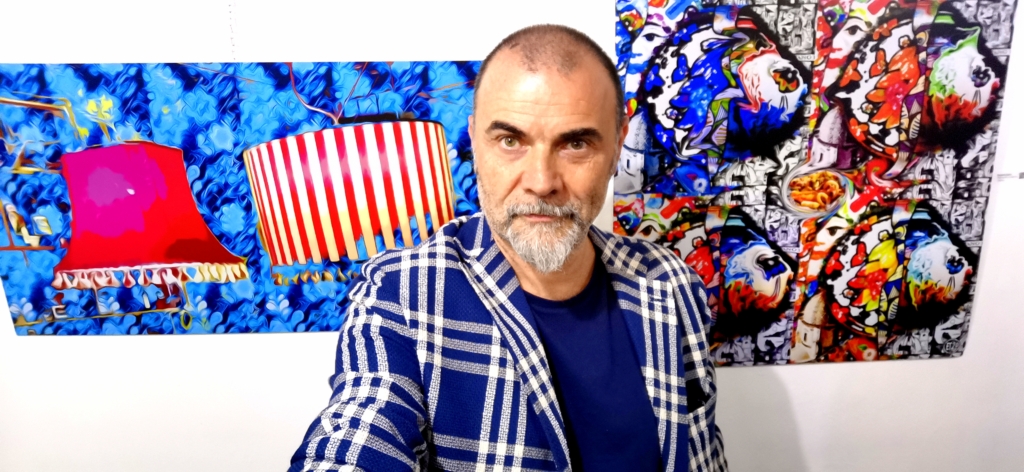
Dinamico, eclettico, sempre in cerca di nuove sfide ed emozioni da cui lasciarsi ispirare, Enrico Tubertini sceglie fin da ragazzo di lavorare con le immagini studiando al Dams di Bologna per poter poi intraprendere la carriera di regista e per farlo inizia dalla gavetta, quella che lo ha condotto prima a collaborare nella realizzazione di videoclip di alcuni tra i principali brani musicali italiani degli anni Novanta e successivamente a entrare nel mondo del cinema e delle produzioni televisive in vari ruoli fino alla realizzazione di suoi cortometraggi uno dei quali premiato a Los Angeles. La sua inquietudine creativa però lo conduce ben presto a distaccarsi da quel cammino, in cui comunque il suo spirito indipendente è costantemente condizionato da tutto un sistema fatto di finanziamenti, compromessi e ritmi frenetici, per cercare una propria strada in cui la sua attitudine verso i colori e le immagini potesse trovare una dimensione più sua, più individuale e appagante per la sua fantasia. Comincia così a ideare un progetto artistico avvalendosi del computer, attraverso il quale inizialmente trasforma inondandole di tonalità decisamente espressioniste le immagini di grandi personaggi del teatro, poi lentamente il suo stile evolve e i profili di volti o di luoghi che desidera immortalare diventano contenitori di piccoli frammenti delle loro stesse vite, dei momenti salienti, dei personaggi che hanno frequentato posti iconici e affascinanti come nel caso dell’opera Positano
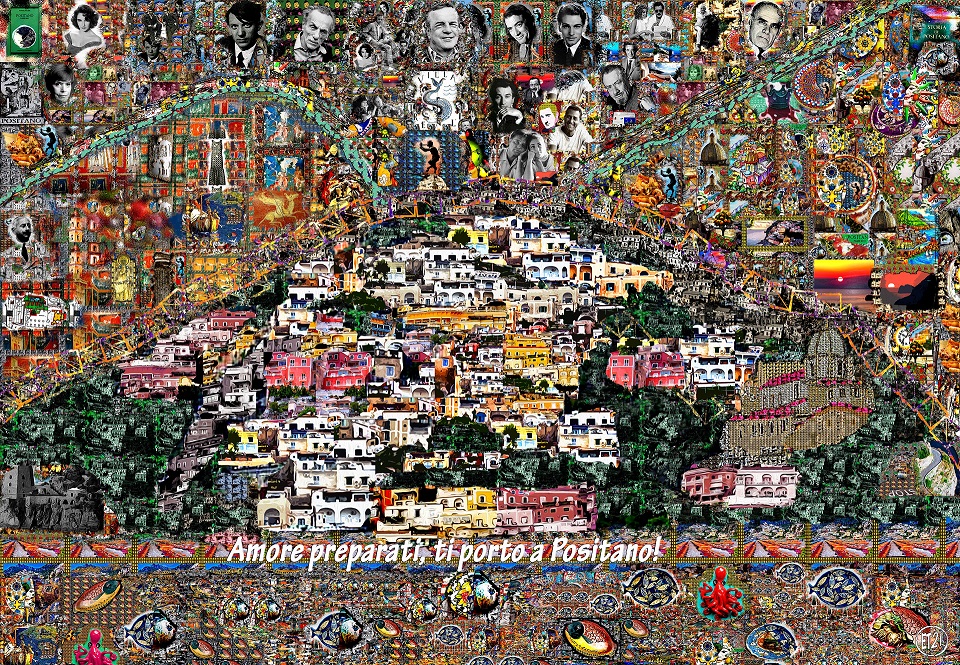
che diviene un memento della dolce vita degli anni Cinquanta, quando gli attori del cinema, principesse e persone di spicco della società di quei tempi si aggiravano tra le sue case colorate. L’immagine finale, quella che si scorge da lontano, è una versione Pop Espressionista della penisola ma quando ci si avvicina all’opera si apre tutto quel caleidoscopio di frammenti dentro cui perdersi per scoprire il racconto che l’artista ne fa. Attraverso questo particolare stile, che Tubertini chiama Personografia, vengono raccontati anche grande figure del passato ma anche persone comuni che gli hanno commissionato un lavoro in cui ritrovarsi, ripercorrere i momenti salienti della propria vita, immortalare un episodio, un affetto, un’attività professionale, sempre personalizzata con tutto ciò che appartiene al mondo interiore e quotidiano del protagonista dell’opera. Confermando il suo amore per i colori, che denota anche un approccio alla vita gioioso e sorridente, l’artista ha recentemente introdotto all’interno della sua produzione una linea creativa parallela alla Personografia, la Trasmutografia, che gli consente di prendere oggetti della quotidianità come per esempio semplici occhiali da vista,
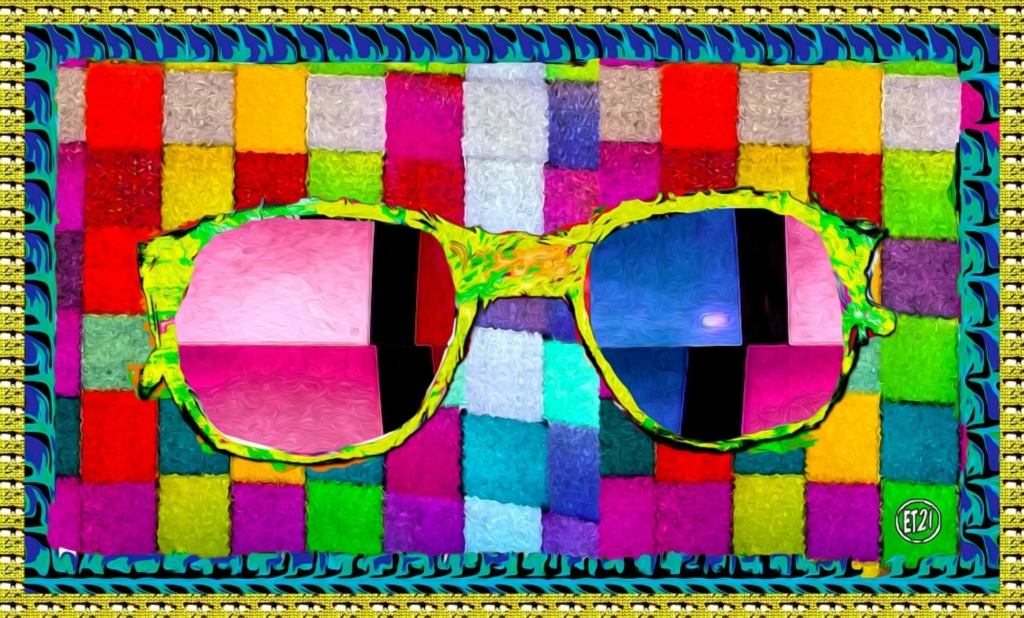
o un ventilatore, una matriosca, una lampada, per trasformarle in divertenti e accattivanti icone Pop Art. Per Enrico Tubertini tutto può diventare un’opera d’arte, rivelando pertanto il suo punto di vista attraverso il quale sembra suggerire all’osservatore che la bellezza si trova ovunque intorno a sé, anche in oggetti che si vedono distrattamente ogni giorno e che solo grazie alla sensibilità dell’artista assumono un valore e una rilevanza inimmaginabili. In questo secondo filone riprende le linee guida tracciate da Andy Warhol tralasciando tuttavia i simboli consumistici o le grandi personalità del mondo dell’epoca, per andare verso un’esaltazione di tutto ciò che è comune ma anche personale perché in fondo ogni cosa, come per Warhol ogni persona, ha il diritto di avere il suo momento di celebrità. Pur essendo digitali Tubertini produce solo opere uniche perché in un’epoca in cui la riproduzione delle immagini è facilmente alla portata di tutti, vuole soffermarsi sull’esclusività di un percorso e di una capacità espressiva che appartengono solo all’artista e in questa veste devono essere esaltate e consegnate al collezionista. Dunque da un lato composizione di immagini, spesso fotografate da lui stesso, che in piccolissime tessere vanno a riempire la figura principale, dall’altro invece la macroriproduzione di oggetti di uso comune messi in primo piano ed evidenziati da colori Pop Espressionisti, denotando la doppia anima di Enrico Tubertini che ora andremo a conoscere meglio attraverso questa intervista.
Enrico, ci racconti la sua esperienza nel mondo del cinema e della televisione; quanto ha contato nel suo approccio alla vita e anche nel suo modo di fare arte? Beh all’inizio tutto era statico con forti contrasti come è la fotografia, spinto dal desiderio di fermare l’attimo per avere ricordi del vissuto. Si dice che i giapponesi facciano molte foto, perché gli manca il punto di fuga della prospettiva, abituati ad una visione, quella dei loro giardini, senza punto di fuga appunto, così vengono trasportati dal desiderio di avere più punti di vista. Altri studi dicono che se quando vai in vacanza fai foto, hai maggiori ricordi non fotografici ma reali della vacanza stessa, avendo dovuto fare una scelta d’inquadratura, quindi un passaggio successivo oltre al semplice guardare. E siccome sono una persona visiva, il semplice guardare non mi bastava, io volevo ricreare o meglio trasformare ciò che vedevo, analizzando i comportamenti umani e partendo dal desiderio di mettere l’occhio dove l’occhio non può andare, così dall’immagine statica sono passato al movimento, seguendo il flusso dei pensieri e cercando sempre un’emozione visiva. Non volevo raccontare storie, non sono mai stato un bravo narratore, bensì suscitare delle emozioni mediante la scelta di racchiudere la realtà, statica o in movimento che fosse, in inquadrature, così ho lavorato nel campo dei videoclip dove si può sperimentare, inventare, azzardare. Sono sempre stato un solitario con il bisogno di condividere oppure un ottimo esecutore se sapevo cosa fare, così col mio entusiasmo e con la voglia di fare, dopo gli studi al Dams, alcuni anni di gavetta nei videoclip fino a firmare alcune regie e altri di sperimentazione al Link di Bologna, sono approdato a Roma, dove forte della mia esperienza nei videoclip, ho ricominciato di nuovo da zero. Si ho ricominciato da zero, perché avevo paura di misurarmi, sapevo di saper fare ma volevo ancora imparare, così ho lavorato in diverse produzioni, anche all’estero ma poi il desiderio di fare da solo ha prevalso dal momento che mettere d’accordo una troupe, produttori e un cast, ti fa scendere a maggiori compromessi rispetto al rapporto con te stesso, la tua arte e al massimo il committente. Così ho deciso di fare l’artista libero ma sperimentale, il pittografo come mi definisco io.
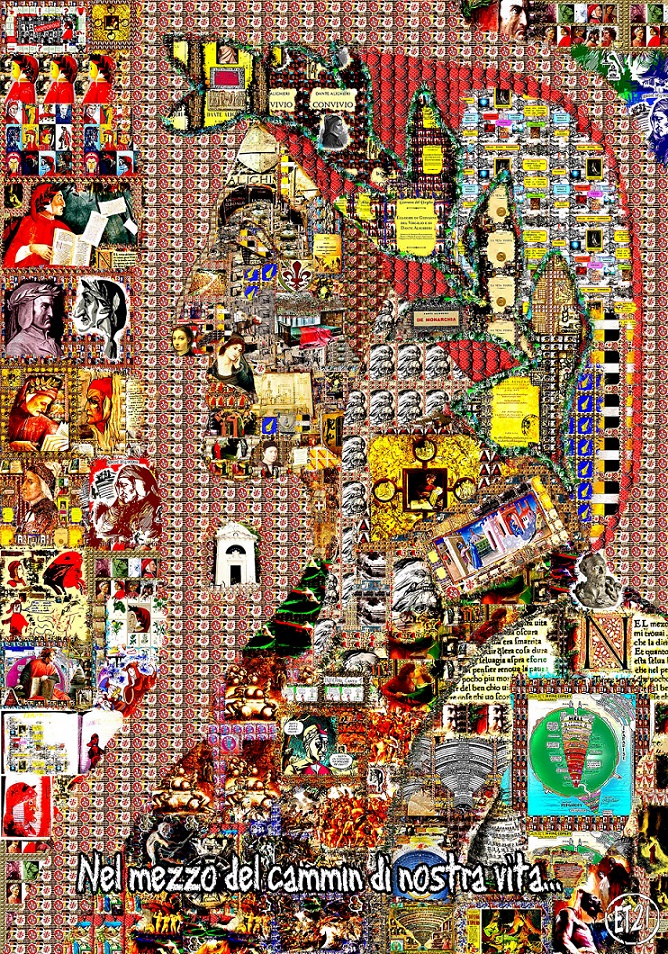
D.
C’è stato un episodio particolare che ha determinato il giro di boa della sua vita? E quanto, se c’è stato, ha influito sulla sua scelta di essere un artista?
Dopo aver realizzato alcuni lavori come regista, con alcuni riconoscimenti e cercando fondi per fare il mio primo lungometraggio, a un certo punto mi sono imbattuto nel mondo dell’imprenditoria partecipando alla costruzione di una tensostruttura teatrale e decidendo di fare un film sulla nascita del medesimo. Ma i tempi si allungavano. il materiale girato, continuava ad aumentare, la fine non si vedeva, iniziai a stressarmi, così nell’attesa che si realizzasse il teatro del quale dovevo essere direttore artistico, senza vedere uno sbocco tra permessi, burocrazia e quant’altro, ho veicolato le mie energie sul mondo del dialogo tra immagini, piuttosto che sulle immagini in movimento. È nata così la pittografia, cioè la rielaborazione d’immagine, con aforisma grafico. Ho iniziato quotidianamente a mettere “le mani addosso”, digitalmente, a tutti personaggi della storia del teatro prevedendo di metterli in dialogo sul perimetro della tensostruttura teatrale in costruzione ma non se ne fece nulla così mi restarono le opere pittografiche che diedero il via alla mia arte digitale. Iniziarono le prime mostre, arrivarono le prime commissioni e così, dopo quella di fotografo sperimentale e regista, ora si affacciava all’orizzonte una terza carriera artistica, nuovamente di natura “statica” ma con meno compromessi, più libertà e con tantissima possibilità evolutiva.
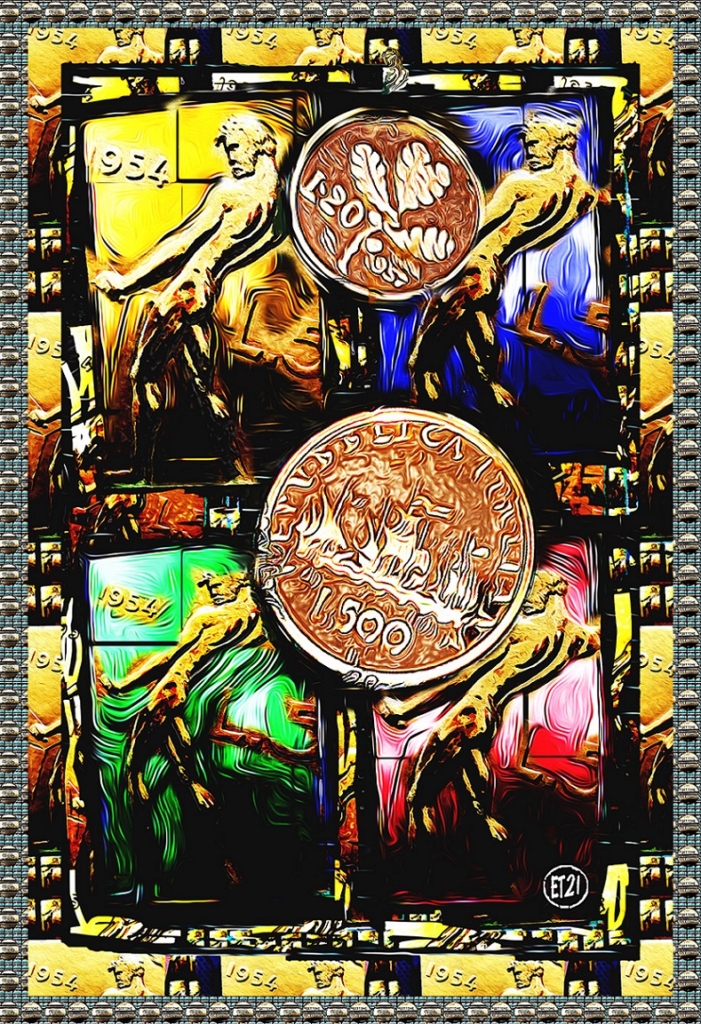
La sua Digital Art è decisamente particolare, innovativa, sia per quanto riguarda le Personografie che per le Trasmutografie che hanno recentemente riscosso molti consensi e apprezzamenti in Oman. Come è arrivato a questo tipo di stile? Quanto è importante la quotidianità, il mondo delle persone, o dei personaggi, per la sua arte?
L’evoluzione naturale della Pittografia, essendo la mia inclinazione quella di rielaborare la realtà, era la Personografia, cioè la realizzazione di un’opera mediante l’utilizzo di una tavolozza digitale ottenuta rielaborando le immagini del committente o altre da me trovate che diventano macchie cromatiche con cui dipingere digitalmente. Il nostro mondo come quello delle persone o dei personaggi famosi è suddivisibile in tanti frame come i fotogrammi di un film che se estrapolati dal loro contesto, messi dentro un’inquadratura e tolti dal campo visivo di 180° diventano forme colorate che possono a loro volta diventare opere, come le Trasmutografie, e con le quali poter creare altre forme, che siano ritratti, paesaggi o loghi. Così creo un’opera personalizzata in cui ogni piccola zona cromatica suscita nel committente una sua emozione personale in quanto estrapolata dal contesto ma ben chiara nel ricordo. Pertanto un paio di occhiali di una persona anziana se messi in evidenza, possono diventare degli occhiali cool alla moda ed essere opera a sé stante con la mia azione di trasformazione, ma anche essere un piccolo particolare di un’opera più grande. Pertanto la quotidianità è per me possibilità di dare sfogo al mio “rabdomantismo”, cioè quell’incontenibile desiderio di collezionare forme da modificare per dargli vita nuova come fa un artigiano di modernariato. Dico sempre non ha senso creare forme nuove quando basta rielaborare quelle esistenti con gusto cromatico e dinamismo elegante poiché i colori e le forme si parlano e si attirano, l’importante è lasciarli agire seguendo il flusso dell’istinto associativo. Quando creo vado in una sorta di trans in cui tutto ha un suo ordine che scopro man mano se mi lascio andare senza freni al desiderio di riempire gli spazi rimasti, con logica e passione, a seconda di ciò che l’opera mi chiede, come se mi parlasse e io eseguissi la sua esigenza di trasformazione. Capita lo stesso quando allestisco una mostra, all’inizio ho un’idea poi mi accorgo che lo spazio è poco rispetto al numero e alle dimensioni dei lavori da esporre perciò inizio a crearmi una logica di adattabilità allo spazio e poi magicamente tutto le opere vanno al loro posto, dandomi la possibilità alla fine di raccontare una storia di dialogo tra di loro.
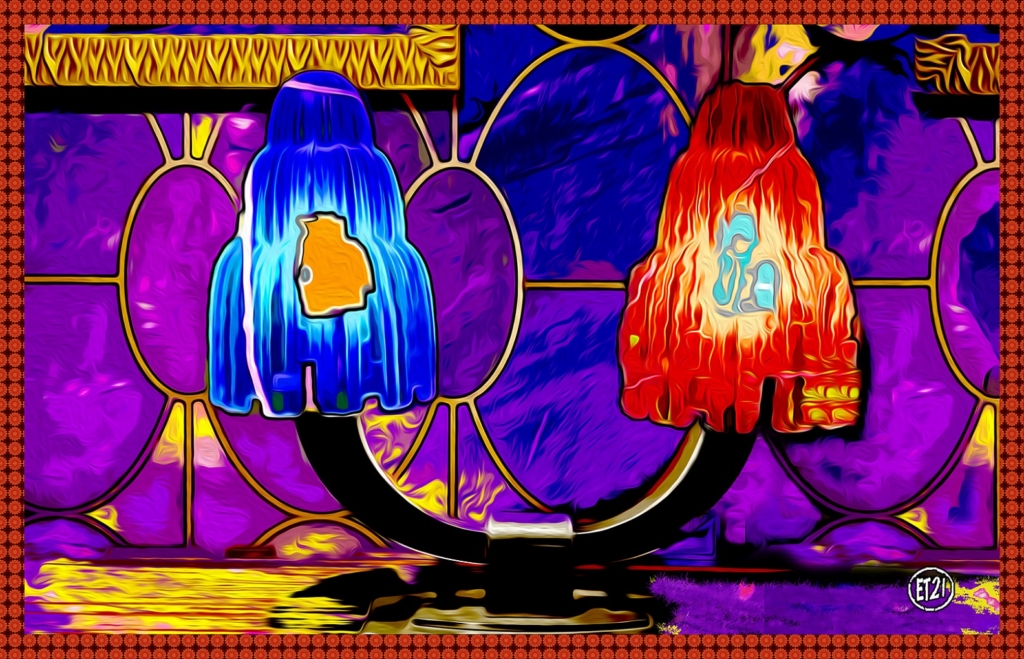
Le sue sono sempre opere uniche, stampate su tela o altri supporti, e corredate di certificato di autenticità. Cosa ne pensa del mondo degli Nft? È un percorso che ha intenzione di intraprendere?
L’unicità dell’opera per me è un’esigenza primaria, dà valore all’opera rendendola originale e non riproducibile, nonostante io sia un artista digitale avendo pertanto la possibilità di creare copie numerate. Penso che se un cliente vuole cambiare supporto, è capitato nel passaggio da stampa su forex a forex piuma, il precedente esperimento lo distruggo. Fin da piccolo ho odiato i videogame, perché non si dava valore alla vita, avendone tante in cui poter rinascere, mentre i miei soldatini, macchinine, giocatori del subbuteo, se li dipingevo li cambiavo, era una scelta e non potevo tornare indietro. Questo è esattamente ciò che voglio realizzare con le mie opere. Ora col dibond, un supporto delicato che mi crea problemi con gli angoli, non ristampo le opere, le restauro, rendendole uniche e vissute. Pertanto l’approdo agli NFT, è un passaggio necessario al quale sto lavorando proprio perché anche in quel caso l’opera non sarebbe replicabile e protetta nella sua unicità.
Ha recentemente esposto a Dubai e in Oman, dunque sta effettuando un importante cammino internazionale, quali sono i suoi prossimi progetti? Dove potranno vedere le sue opere i nostri lettori?
Si è vero, negli Emirati sembra che i miei lavori piacciano e incuriosiscano, vedremo gli sviluppi, ci sono le possibilità di importanti evoluzioni. A breve parteciperò al ART 3F di Montecarlo, poi esporrò in Norvegia e poi Bruxelles, poi una personale a Roma e nella natia Bologna. Nel 2023 invece parteciperò al SIAF di Shanghai dal cui comitato sono stato selezionato già dal 2021 ma che è stato rimandato a causa della pandemia. Per ora i programmi pianificati sono questi ma non escludo che possano aggiungersi altre esposizioni. Sto anche pensando di sperimentare l’utilizzo della resina dopo la stampa delle opere, è un progetto che sto lasciando maturare ma che ho in mente di realizzare al più presto.
ENRICO TUBERTINI-CONTATTI
Email: pittoet@gmail.com
Sito web: https://enricotubertini.wixsite.com/pittografia
Facebook: https://www.facebook.com/enricotubertini/
Instagram: https://www.instagram.com/enricotuber/
Marta Lock’s interviews:
Enrico Tubertini, from cinema to Digital Art to immerse in his kaleidoscopic world of colours
Dynamic, eclectic, always in search of new challenges and emotions to be inspired by, Enrico Tubertini choses to work with images as a boy, studying at DAMS in Bologna in order to pursue a career as a film director. To do so, he started from the bottom, which first led him to collaborate in the production of video clips of some of the main Italian music tracks of the 1990s and then to enter the world of cinema and television productions in various roles until the creation of his own short films, one of which won an award in Los Angeles. His creative restlessness, however, soon led him to detach himself from that path, in which in any case his independent spirit was constantly conditioned by a whole system of financing, compromises and frenetic rhythms, in order to seek his own path in which his aptitude for colours and images could find a dimension that was more his own, more individual and more fulfilling for his imagination. He thus began to devise an artistic project using the computer, through which he initially transformed the images of great theatre personalities by flooding them with decidedly expressionist tones, then slowly his style evolved and the profiles of faces or places he wished to immortalise became containers of small fragments of their own lives, of the salient moments, of the characters who frequented iconic and fascinating places, as in the case of the artwork Positano, which becomes a memento of the dolce vita of the 1950s, when film actors, princesses and prominent members of society of the time roamed its colourful houses. The final image, the one you see from afar, is a Pop Expressionist version of the peninsula, but when you get closer to the work, it opens up that whole kaleidoscope of fragments within which losing oneself to discover the artist’s account of it. Through this particular style, which Tubertini calls Personography, he also narrates great figures of the past, but also ordinary people who have commissioned him an artwork in which they can find themselves, retrace the salient moments of their lives, immortalise an episode, an affection, a professional activity, always personalised with everything that belongs to the inner, everyday world of the work’s protagonist. Confirming his love for colours, which also denotes a joyful and smiling approach to life, the artist has recently introduced within his production a creative line parallel to Personography, the Transmutography, which allows him to take everyday objects such as simple eyeglasses, or a fan, a matryoshka doll, a lamp, to transform them into amusing and captivating Pop Art icons. For Enrico Tubertini, everything can become a work of art, thus revealing his point of view through which he seems to suggest to the observer that beauty can be found everywhere around, even in objects that one sees distractedly every day and that only thanks to the artist’s sensitivity take on an unimaginable value and relevance. In this second strand, he takes up the guidelines traced by Andy Warhol, leaving aside, however, consumerist symbols or the great personalities of the world of the time, in order to move towards an exaltation of everything that is common but also personal, because after all, everything, like for Warhol every person, has the right to have its moment of celebrity. While being digital, Tubertini produces only unique artworks because in an age in which the reproduction of images is easily within everyone’s reach, he wants to dwell on the exclusiveness of a path and an expressive capacity that belong only to the artist and in this capacity must be exalted and delivered to the collector. So, on the one hand, a composition of images, often photographed by himself, which in very small tesserae fill in the main figure, and on the other hand, the macro-reproduction of everyday objects placed in the foreground and highlighted by Pop Expressionist colours, denoting the dual soul of Enrico Tubertini, whom we will now get to know better through this interview.
Enrico, tell us about your experience in the world of film and television; how much did it count in your approach to life and also in your way of making art?
Well, in the beginning, everything was static with strong contrasts as photography is, driven by the desire to stop the moment to have memories of the lived experience. It is said that the Japanese take a lot of photos because they lack the vanishing point of perspective, accustomed to a vision, that of their gardens, without a vanishing point, so they are carried away by the desire to have more points of view. Other studies say that if when you go on holiday you take pictures, you have more non-photographic but real memories of the holiday itself, having had to make a choice of framing, so a next step beyond just looking. And as I am a visual person, simply looking was not enough for me, I wanted to recreate or rather transform what I saw, analysing human behaviour and starting from the desire to put the eye where the eye cannot go, so from the static image I moved on to movement, following the flow of thoughts and always looking for a visual emotion. I didn’t want to tell stories, I’ve never been a good storyteller, but to arouse emotions by choosing to enclose reality, whether static or in motion, in shots, so I worked in the field of video clips where you can experiment, invent, venture. I have always been a loner with a need to share, or an excellent performer if I knew what to do, so with my enthusiasm and desire to do, after studying at DAMS, a few years of apprenticeship in video clips and some directing and other experimentation at Link in Bologna, I landed in Rome, where, on the strength of my experience in video clips, I started from scratch again. Yes, I started from scratch again, because I was afraid of measuring myself, I knew I knew how to do it but I still wanted to learn, so I worked in several productions, even abroad, but then the desire to go it alone prevailed, since getting a crew, producers, and a cast to agree makes you compromise more than the relationship with yourself, your art, and at most the client. So I decided to be a free but experimental artist, the pictographer as I call myself.
Was there a particular episode that determined the turning point in your life? And how much, if ther was, did it influence your choice to be an artist?
After having done some work as a director, with some awards and looking for funds to make my first feature film, at some point I stumbled into the world of entrepreneurship by participating in the construction of a theatrical marquee and deciding to make a film about its birth. But the time was getting longer. the material shot, it kept increasing, the end was not in sight, I started to stress myself out, so while waiting for the theatre of which I was to be artistic director to be realised, without seeing an outlet between permits, bureaucracy and whatnot, I channelled my energies on the world of dialogue between images, rather than on moving images. This is how Pictography was born, i.e. the reworking of images with graphic aphorism. I began daily to digitally ‘lay my hands on’ all the characters from the history of theatre, planning to put them in dialogue on the perimeter of the theatre marquee under construction, but nothing came of it, so I was left with the pictographic artworks that kick-started my digital art. The first exhibitions began, the first commissions arrived and so, after that as an experimental photographer and director, now a third artistic career was on the horizon, again of a ‘static’ nature but with less compromise, more freedom and with a lot of evolutionary possibilities.
Your Digital Art is decidedly distinctive, innovative, both in terms of the Personographies and the Transmutographies that have recently received much acclaim and appreciation in Oman. How did you arrive at this type of style? How important is the everyday, the world of people, or characters, for your art? The natural evolution of Pictography, as my inclination was to rework reality, was Personography, i.e. the creation of a work through the use
of a digital palette obtained by reworking the client’s images or others that I found, which become colour spots with which to paint digitally. Our world like that of people or celebrities can be divided into many frames like the frames of a film that when taken out of their context, put into a frame and taken out of the field of vision by 180° become coloured shapes that can in turn become artworks, such as Transmutographies, and with which other shapes can be created, be they portraits, landscapes or logos. In this way, I create a personalised work in which each small area of colour arouses a personal emotion in the client as it is taken out of context but clear in the memory. Therefore, a pair of glasses of an elderly person, if highlighted, can become fashionable cool glasses and be an artwork in itself with my transforming action, but also be a small detail of a larger work. Therefore, everyday life is for me an opportunity to give vent to my ‘dowsing’, i.e. that irrepressible desire to collect forms to modify in order to give them new life like a modern-day craftsman does. I always say there is no point in creating new shapes when it is enough to rework existing ones with chromatic taste and elegant dynamism because colours and shapes talk and attract each other, the important thing is to let them act following the flow of associative instinct. When I create I go into a sort of trance in which everything has its own order that I gradually discover if I let myself go unrestrainedly to the desire to fill the remaining spaces, with logic and passion, according to what the artwork asks of me, as if it were speaking to me and I were performing its need for transformation. The same thing happens when I set up an exhibition, at the beginning I have an idea then I realise that the space is small compared to the number and size of the artworks to be exhibited so I start to create a logic of adaptability to the space and then magically all the artworks go in their place, giving me the possibility at the end to tell a story of dialogue between them.
Yours are always unique works, printed on canvas or other media, and accompanied by a certificate of authenticity. What do you think of the world of Nft? Is it a path you intend to take?
The uniqueness of the work for me is a primary requirement, it gives value to the artwork by making it original and not reproducible, even though I am a digital artist and therefore have the possibility of creating numbered copies. I think that if a customer wants to change medium, as happened in the switch from forex to feather forex, I destroy the previous experiment. Since I was a kid I hated video games, because you didn’t value life, having so many to be reborn into, whereas my toy soldiers, toy cars, subbuteo players, if I painted them I would change them, it was a choice and I couldn’t go back. This is exactly what I want to achieve with my artworks. Now with dibond, a delicate medium that causes me problems with corners, I don’t reprint the works, I restore them, making them unique and lived-in. Therefore, the move to NFT is a necessary step that I am working on precisely because even then in this case the work artwould not be replicable and so protected in its uniqueness.
You have recently exhibited in Dubai and Oman, so you are making an important international journey, what are your next projects? Where will our readers be able to see your arworks? Yes it is true, in the Emirates my works seem to be liked and intrigued, we will see the developments, there are possibilities for important growths. I will soon participate in the ART 3F in Monte Carlo, then I will exhibit in Norway and then Brussels, then a solo exhibition in Rome
of a digital palette obtained by reworking the client’s images or others that I found, which become colour spots with which to paint digitally. Our world like that of people or celebrities can be divided into many frames like the frames of a film that when taken out of their context, put into a frame and taken out of the field of vision by 180° become coloured shapes that can in turn become artworks, such as Transmutographies, and with which other shapes can be created, be they portraits, landscapes or logos. In this way, I create a personalised work in which each small area of colour arouses a personal emotion in the client as it is taken out of context but clear in the memory. Therefore, a pair of glasses of an elderly person, if highlighted, can become fashionable cool glasses and be an artwork in itself with my transforming action, but also be a small detail of a larger work. Therefore, everyday life is for me an opportunity to give vent to my ‘dowsing’, i.e. that irrepressible desire to collect forms to modify in order to give them new life like a modern-day craftsman does. I always say there is no point in creating new shapes when it is enough to rework existing ones with chromatic taste and elegant dynamism because colours and shapes talk and attract each other, the important thing is to let them act following the flow of associative instinct. When I create I go into a sort of trance in which everything has its own order that I gradually discover if I let myself go unrestrainedly to the desire to fill the remaining spaces, with logic and passion, according to what the artwork asks of me, as if it were speaking to me and I were performing its need for transformation. The same thing happens when I set up an exhibition, at the beginning I have an idea then I realise that the space is small compared to the number and size of the artworks to be exhibited so I start to create a logic of adaptability to the space and then magically all the artworks go in their place, giving me the possibility at the end to tell a story of dialogue between them.
Yours are always unique works, printed on canvas or other media, and accompanied by a certificate of authenticity. What do you think of the world of Nft? Is it a path you intend to take?
The uniqueness of the work for me is a primary requirement, it gives value to the artwork by making it original and not reproducible, even though I am a digital artist and therefore have the possibility of creating numbered copies. I think that if a customer wants to change medium, as happened in the switch from forex to feather forex, I destroy the previous experiment. Since I was a kid I hated video games, because you didn’t value life, having so many to be reborn into, whereas my toy soldiers, toy cars, subbuteo players, if I painted them I would change them, it was a choice and I couldn’t go back. This is exactly what I want to achieve with my artworks. Now with dibond, a delicate medium that causes me problems with corners, I don’t reprint the works, I restore them, making them unique and lived-in. Therefore, the move to NFT is a necessary step that I am working on precisely because even then in this case the work artwould not be replicable and so protected in its uniqueness.
You have recently exhibited in Dubai and Oman, so you are making an important international journey, what are your next projects? Where will our readers be able to see your arworks? Yes it is true, in the Emirates my works seem to be liked and intrigued, we will see the developments, there are possibilities for important growths. I will soon participate in the ART 3F in Monte Carlo, then I will exhibit in Norway and then Brussels, then a solo exhibition in Rome
of a digital palette obtained by reworking the client’s images or others that I found, which become colour spots with which to paint digitally. Our world like that of people or celebrities can be divided into many frames like the frames of a film that when taken out of their context, put into a frame and taken out of the field of vision by 180° become coloured shapes that can in turn become artworks, such as Transmutographies, and with which other shapes can be created, be they portraits, landscapes or logos. In this way, I create a personalised work in which each small area of colour arouses a personal emotion in the client as it is taken out of context but clear in the memory. Therefore, a pair of glasses of an elderly person, if highlighted, can become fashionable cool glasses and be an artwork in itself with my transforming action, but also be a small detail of a larger work. Therefore, everyday life is for me an opportunity to give vent to my ‘dowsing’, i.e. that irrepressible desire to collect forms to modify in order to give them new life like a modern-day craftsman does. I always say there is no point in creating new shapes when it is enough to rework existing ones with chromatic taste and elegant dynamism because colours and shapes talk and attract each other, the important thing is to let them act following the flow of associative instinct. When I create I go into a sort of trance in which everything has its own order that I gradually discover if I let myself go unrestrainedly to the desire to fill the remaining spaces, with logic and passion, according to what the artwork asks of me, as if it were speaking to me and I were performing its need for transformation. The same thing happens when I set up an exhibition, at the beginning I have an idea then I realise that the space is small compared to the number and size of the artworks to be exhibited so I start to create a logic of adaptability to the space and then magically all the artworks go in their place, giving me the possibility at the end to tell a story of dialogue between them.
Yours are always unique works, printed on canvas or other media, and accompanied by a certificate of authenticity. What do you think of the world of Nft? Is it a path you intend to take?
The uniqueness of the work for me is a primary requirement, it gives value to the artwork by making it original and not reproducible, even though I am a digital artist and therefore have the possibility of creating numbered copies. I think that if a customer wants to change medium, as happened in the switch from forex to feather forex, I destroy the previous experiment. Since I was a kid I hated video games, because you didn’t value life, having so many to be reborn into, whereas my toy soldiers, toy cars, subbuteo players, if I painted them I would change them, it was a choice and I couldn’t go back. This is exactly what I want to achieve with my artworks. Now with dibond, a delicate medium that causes me problems with corners, I don’t reprint the works, I restore them, making them unique and lived-in. Therefore, the move to NFT is a necessary step that I am working on precisely because even then in this case the work artwould not be replicable and so protected in its uniqueness.
You have recently exhibited in Dubai and Oman, so you are making an important international journey, what are your next projects? Where will our readers be able to see your arworks? Yes it is true, in the Emirates my works seem to be liked and intrigued, we will see the developments, there are possibilities for important growths. I will soon participate in the ART 3F in Monte Carlo, then I will exhibit in Norway and then Brussels, then a solo exhibition in Rome and in my native Bologna. In 2023, on the other hand, I will participate in the SIAF in Shanghai by whose committee I was already selected in 2021 but which was postponed due to the pandemic. For now, these are the planned programmes, but I do not rule out the possibility of adding other exhibitions. I am also thinking of experimenting with the use of resin after printing the artworks, it is a project I am letting mature but which I plan to realise soon.

